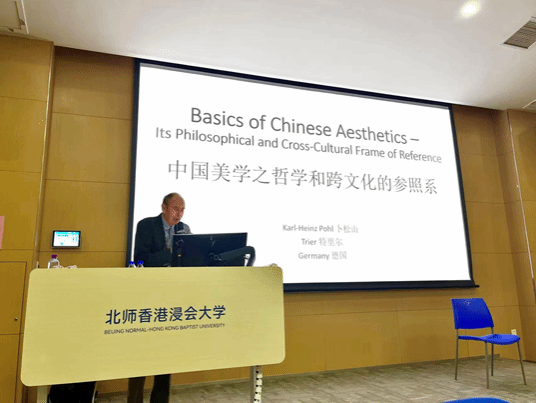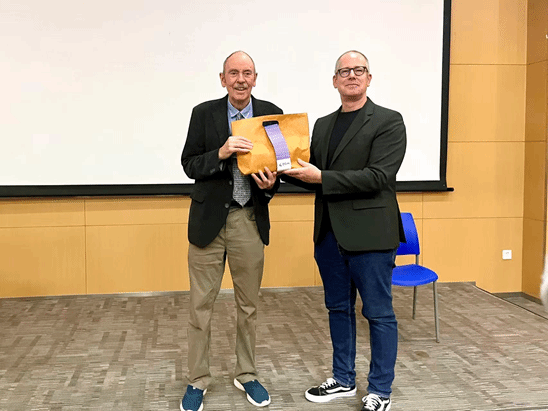
October 28, 2025 – Professor Karl-Heinz POHL, Honorary Professor of Sinology at Trier University, Germany, delivered an insightful lecture titled “Basics of Chinese Aesthetics – Its Philosophical and Cross-Cultural Frame of Reference” to faculty and students from the Department of Communication. The event was hosted by Dr. Markus Georg Thomas HEIDINGSFELDER.

Prof. Karl-Heinz POHL was sharing insights into Chinese aesthetics.
At the beginning of the lecture, Prof. POHL pointed out that “aesthetics” as a cognitive discipline was proposed by Western scholars and was introduced to China in the late Qing Dynasty. He argued against defining traditional Chinese aesthetics simply based on Western preferences. Professor POHL emphasized the linguistic roots of Chinese aesthetics in pictographs, noting that Chinese philosophical texts often communicate through images. He explained “对仗” (Parallelism), particularly in classical Chinese, using examples where understanding relies on recognizing parallel structures, and connected this tendency to “阴阳说” (Yin-Yang Thought), which perceives the world through complementary binary oppositions.

Prof. Karl-Heinz POHL explained “Parallelism” to the audience.
The following part systematically examined the profound influence of Confucianism, Daoism, and Buddhist thought within Chinese aesthetics. From Confucianism, Prof. POHL discussed the pursuit of balance/harmony and the relationship between art and morality, citing concepts like “诗言志” [poetry as a way of expressing (moral) intent (zhi)] and “文以载道” [literature as a vehicle for the expression of the (moral) “Way” (Dao)]. Regarding Daoism, he elaborated that Daoism advocated for “hanxu含蓄” (implicitness) expression, embodying a state of “Artless Art”. He particularly pointed out core categories in Chinese aesthetics in the three key terms: “神” (Shen), “天” (Tian), and “气” (Qi). He also touched upon the Buddhist dialectics of “色” (Form) and “空” (Emptiness) and its influence.
Moreover, Prof. POHL explored Chinese aesthetics under Western influence from an inter-cultural dimension. He pointed out the creative misunderstanding in translating “Aesthetics” as “美学” (Meixue), leading modern Chinese aesthetics to often be perceived as the “study of beauty” (Beautology), viewed as one of the most sublime features of Chinese culture rather than a purely academic discipline. This perception, he suggested, is linked to a reception delayed by approximately 100 years of German idealist aesthetics in 20th-century China.
Prof. POHL concluded the lecture with a reading from Goethe’s poem “Nature and Art”.
During the lively Q&A session, participants actively engaged Prof. POHL in discussions on “Chinese dialectics” and “distinctions between literature and aesthetics in Western works”. At the end of the event, Dr. Markus Georg Thomas HEIDINGSFELDER presented a souvenir to Prof. POHL.

Prof. Karl-Heinz POHL and Dr. Markus Georg Thomas HEIDINGSFELDER took a group photo after the lecture.
Reporter / Photo: Zheng Zhiyu